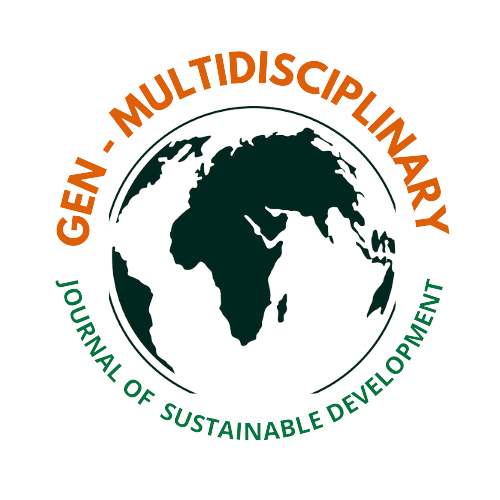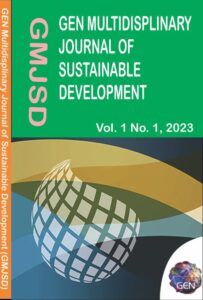
Authors' Guidelines
Researchers of multiple disciplines of sustainable development are invited to submit manuscripts.

Peer Review
GMJSD allows articles/manuscripts to be commented upon and evaluated by independent experts in the field of the authors and/or the article topic. This allows the editor to assess the suitability of the article. When there is a technical issue on any article, peer review will be at the prerogative of the editors.
Review Process
The authors and reviewers are working to meet GMJSD’s editorial criteria, any insufficient manuscript will be rejected. The reviewer’s advice is strictly adhered to by the editors to make valuable decisions. Reviewers will indicate any of the following decisions; Accept submission, revision is necessary and rejection. Reviewers will give adequate reasons for any of the aforementioned decisions. This will provide the editors with a primary responsibility of informing the readers and the scientific community about the arguments in support or opposition to the publication.
We believe that when a reviewer accepts the responsibility of reviewing the article, such a reviewer will also be responsible for assessing the revision from the authors. We take with all seriousness the comments of the reviewers. Where one reviewer opposes the article, GMJSD will consider other reviewers to ascertain if the opposing reviewer is too critical or not, hence, we bring another reviewer to resolve the discrepancy.
Ethical Considerations
The peer review process is highly confidential and ethics is followed. Authors will be duly informed of the final decisions. Editorial board members will not be involved in any decision concerning their manuscripts. Authors should not know the identities of the reviewers. GMJSD shall give some days that reviewers should adhere to, if reviewers need an extension, they are free to request for more days.
Submitting articles
All journals must be submitted via our online submission system.
Please prepare your manuscripts in the English language. Either British and American English are accepted but be consistent in spelling and usage throughout the article and avoid mixing both. Before submitting the papers, authors are strongly encouraged to conduct language editing by native-level readers.
Provide the following data on the title page.
- Title. Concise and informative. Titles are often used in information-retrieval systems. Avoid abbreviations and formulas where possible.
- Author names and affiliations. Present the authors’ affiliation addresses (where the actual work was done) below the names. Indicate all affiliations with a lower-case superscript letter immediately after the author’s name.
- Corresponding author. Clearly indicate who is willing to handle correspondence at all stages of refereeing and publication, also post-publication.
- Abstract. A concise and factual abstract is required (maximum length of 200 words). The abstract should briefly state the purpose of the research, the principal results, and major conclusions.
- Keywords. Immediately after the abstract, provide a maximum of 5 keywords
- Turnitin. Kindly note that for a manuscript to be considered for processing, it must demonstrate a similarity index not exceeding 10%. Please be advised that all submissions will be subject to rigorous screening for originality, employing the Turnitin plagiarism detection service, before any further processing steps. Articles not within the threshold will be rejected unprocessed.
Article Structure
- Subdivisions. Divide your article into clearly defined and numbered sections. Subsections should be numbered 1., 2., (then 1.1, 1.1.1, 1.1.2), 1.2, etc. (the abstract is not included in section numbering).
- Figures. High-resolution graphics files must also be provided separately from the main text file. Ensure that each illustration has a caption. Supply captions separately, not attached to the figure. Keep text in the illustrations themselves to a minimum but explain all symbols and abbreviations used.
- Tables. Number tables consecutively in accordance with their appearance in the text all tables must be in size 10 of Times New Roman font.
- Acknowledgement. Place acknowledgements, including information on grants received, before the references, in a separate section.
- References should be arranged first alphabetically and then further sorted chronologically if necessary. More than one reference from the same author(s) in the same year must be identified by the letters “a”, “b”, “c”, etc. reference style is APA format of 7th Edition.
Article Processing Charges (APC)
- The Journal requires an APC of 200 USD for each manuscript accepted for publication. This fee is compulsory for all authors and is payable upon the acceptance of the manuscript. The APC is essential in defraying the costs associated with manuscript processing, editorial management, and the dissemination of published articles. We guarantee a fair and comprehensive review process for all submissions, ensuring a high standard of scholarly work. The APC is integral to sustaining the journal’s integrity and quality. Also, we would like to assure authors that there are no additional hidden fees or surcharges.
Authors are requested to register and submit their manuscripts using our submission link. The following is the publication process;
- Step 1. Based on the double-blind peer review policy and formatting prescriptions, the manuscript is submitted after the authors have registered.
- Step 2. The journal scope must be followed by the authors, otherwise, the editor-in-chief has the right to reject the manuscripts.
- Step 3. The maximum of 10% similarity index is checked by the editor-in-chief, anything above 10 percent will be rejected
- Step 4. Manuscripts will be assigned to suitable reviewers and experts as the case may be.
- Step 5. The double-blind peer reviewers will receive the manuscripts and follow the guidelines of the author to review the manuscripts.
- Step 6. The reviewers will upload their submission and the decision will be taken and communicated to the authors in due course.
- Step 7. Authors are to make corrections and send the revised articles back. The accepted manuscripts will be formatted and galley proof will be sent back to the authors before final publication.

Register
You can register with the Journal to contribute with articles by filling in the registration form and become a contributing author of the GEN-Multidisciplinary Journal of Sustainable Development.
Designed & hosted by Be IT Specialists